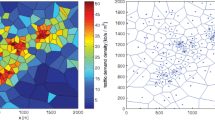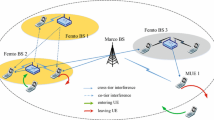Abstract
In this paper we study themobile removal problem in a cellular PCS network where transmitter powers are constrained and controlled by a Distributed Constrained Power Control (DCPC) algorithm. Receivers are subject to non-negligible noise, and the DCPC attempts to bring each receiver's CIR above a given target. To evaluate feasibility and computational complexity, we assume a paradigm where radio bandwidth is scarce and inter-base station connection is fast. We show that finding the optimal removal set is an NP-Complete problem, giving rise for heuristic algorithms. We study and compare among three classes of transmitter removal algorithms. Two classes consist of algorithms which are invoked only when reaching a stable power vector under DCPC. The third class consist of algorithms which combine transmitter removals with power control. These areOne-by-one Removals, Multiple Removals, andPower Control with Removals Combined. In the class of power control with removals combined, we also consider a distributed algorithm which uses the same local information as DCPC does. All removal algorithms are compared with respect to their outage probabilities and their time to converge to a stable state. Comparisons are made in a hexagonal macro-cellular system, and in two metropolitan micro-cellular systems. ThePower Control with Removals Combined algorithm emerges as practically the best approach with respect to both criteria.
Similar content being viewed by others
References
J.M. Aein, Power balancing in systems employing frequency reuse, Comsat Tech. Rev. 3 (2) (1973).
M. Almgren, H. Andersson and K. Wallstedt, Power control in a cellular system,Proc. IEEE Veh. Tech. Conf., VTC-94 (1994) pp. 833–837.
M. Andersin, Z. Rosberg and J. Zander, A soft admission in cellular PCS with constrained power control and noise,Proc. 5th WINLAB Workshop (1995).
N. Bambos and G.J. Pottie, On power control in high capacity cellular radio networks,Proc. 3rd WINLAB Workshop (1992).
N. Bambos, S.C. Chen and G.J. Pottie, Channel access algorithms with active link protection for wireless communication networks with power control, Technical Report, UCLA-ENG-95-114, Department of Electrical Engineering, UCLA (1995).
J.-E. Berg, A simplified street width dependent microcell path loss model, COST 231, TD(94)035 (1994).
J.-E. Berg, R. Bownds and F. Lotse, Path loss and fading models for microcells at 900 MHz,Proc. IEEE Veh. Tech. Conf., VTC-92 (1994) pp. 666–671.
G.J. Foschini, A simple distributed autonomous power control algorithm and its convergence, IEEE Trans. Veh. Tech. 42(4) (1993).
M.R. Garey and D.S. Johnson,Computers and Intractability: A Guide to the Theory of NP-completeness. (W.H. Freeman, San Francisco, 1979).
S.A. Grandhi, R. Vijayan and D.J. Goodman, A distributed algorithm for power control in cellular radio systems,13th Annual Allerton Conf. on Commun., Contr. and Computing, Monticello, Illinois (1992).
S.A. Grandhi, R. Vijayan, D.J. Goodman and J. Zander, Centralized power control in cellular radio systems, IEEE Trans. Veh. Tech. 42(4) (1993).
S.A. Grandhi and J. Zander, Constrained power control in cellular radio system,Proc. IEEE Veh. Tech. Conf., VTC-94 (1994) pp. 824–828.
S.A. Grandhi, J. Zander and R. Yates, Constrained power control, Wireless Personal Commun. 1(4) (1995).
M. Gudmundson, Cell planning in Manhattan environments,Proc. IEEE Veh. Tech. Conf., VTC-92 (1992) pp. 435–438.
S.V. Handy, An algorithm for combined cell-site selection and power control to maximize cellular spread spectrum capacity, IEEE J. Select. Areas Commun., special issue on Fundamentals of Networking, to appear.
J.C. Lin, T.H. Lee and Y.T. Su, Power control algorithm for cellular radio systems, IEEE Trans. Veh. Tech. 44(1) (1995).
H.J. Meyerhoff, Methods for computing the optimum power balance in multibeam satellite, Comsat Tech. Rev. 4(1) (1974).
D. Mitra, An asynchronous distributed algorithm for power control in cellular radio systems,Proc. 4th WINLAB Workshop (1993).
R.W. Nettleton and H. Alavi, Power control for spread-spectrum cellular mobile radio system,Proc. IEEE Veh. Tech. Conf., VTC-83 (1983), pp. 242–246.
R. Yates and C.Y. Huang, Optimal uplink control and base station assignment,Proc. 3rd ICUPC, San Diego, CA (1994) pp. 247–251.
J. Zander, Performance of optimum transmitter power control in cellular radio systems, IEEE Trans. Veh. Tech. 41(1) (1992).
J. Zander, Distributed cochannel interference control in cellular radio systems, IEEE Trans. Veh. Tech. 41(3) (1992).
Author information
Authors and Affiliations
Additional information
This research has been done while the 2nd author was visiting at the Royal Inst. of Tech. under a grant from ISS '90 foundation, Sweden.
Rights and permissions
About this article
Cite this article
Andersin, M., Rosberg, Z. & Zander, J. Gradual removals in cellular PCS with constrained power control and noise. Wireless Netw 2, 27–43 (1996). https://doi.org/10.1007/BF01201460
Issue Date:
DOI: https://doi.org/10.1007/BF01201460




